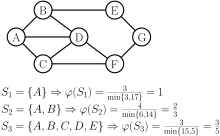Conductance (graph)
In graph theory the conductance of a graph G=(V,E) measures how "well-knit" the graph is: it controls how fast a random walk on G converges to its stationary distribution. The conductance of a graph is often called the Cheeger constant of a graph as the analog of its counterpart in spectral geometry. Since electrical networks are intimately related to random walks with a long history in the usage of the term "conductance", this alternative name helps avoid possible confusion.
| Network science | ||||
|---|---|---|---|---|
| Network types | ||||
| Graphs | ||||
|
||||
| Models | ||||
|
||||
| ||||
|
||||

The conductance of a cut in a graph is defined as:
where the are the entries of the adjacency matrix for G, so that
is the total number (or weight) of the edges incident with S. is also called a volume of the set .
The conductance of the whole graph is the minimum conductance over all the possible cuts:
Equivalently, conductance of a graph is defined as follows:
For a d-regular graph, the conductance is equal to the isoperimetric number divided by d.
Generalizations and applications
In practical applications, one often considers the conductance only over a cut. A common generalization of conductance is to handle the case of weights assigned to the edges: then the weights are added; if the weight is in the form of a resistance, then the reciprocal weights are added.
The notion of conductance underpins the study of percolation in physics and other applied areas; thus, for example, the permeability of petroleum through porous rock can be modeled in terms of the conductance of a graph, with weights given by pore sizes.
Conductance also helps measure the quality of a Spectral clustering. The maximum among the conductance of clusters provides a bound which can be used, along with inter-cluster edge weight, to define a measure on the quality of clustering. Intuitively, the conductance of a cluster (which can be seen as a set of vertices in a graph) should be low. Apart from this, the conductance of the subgraph induced by a cluster (called "internal conductance") can be used as well.
Markov chains
For an ergodic reversible Markov chain with an underlying graph G, the conductance is a way to measure how hard it is to leave a small set of nodes. Formally, the conductance of a graph is defined as the minimum over all sets of the capacity of divided by the ergodic flow out of . Alistair Sinclair showed that conductance is closely tied to mixing time in ergodic reversible Markov chains. We can also view conductance in a more probabilistic way, as the minimal probability of leaving a small set of nodes given that we started in that set to begin with. Writing for the conditional probability of leaving a set of nodes S given that we were in that set to begin with, the conductance is the minimal over sets that have a total stationary probability of at most 1/2.
Conductance is related to Markov chain mixing time in the reversible setting.
References
- Béla Bollobás (1998). Modern graph theory. GTM. 184. Springer-Verlag. p. 321. ISBN 0-387-98488-7.
- Kannan, R.; Vempala, S.; Vetta, A. (May 2004). "On clusterings: Good, bad and spectral" (PDF). J. ACM. 51 (3): 497–515. doi:10.1145/990308.990313.
- Fan Chung (1997). Spectral Graph Theory. CBMS Lecture Notes. 92. AMS Publications. p. 212. ISBN 0-8218-0315-8.
- A. Sinclair. Algorithms for Random Generation and Counting: A Markov Chain Approach. Birkhauser, Boston-Basel-Berlin, 1993.
- D. Levin, Y. Peres, E. L. Wilmer: Markov Chains and Mixing Times
